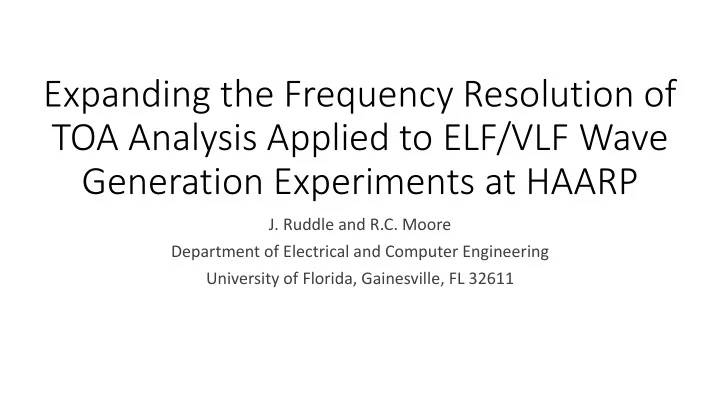

Expanding the Frequency Resolution of TOA Analysis Applied to ELF/VLF Wave Generation Experiments at HAARP J. Ruddle and R.C. Moore Department of Electrical and Computer Engineering University of Florida, Gainesville, FL 32611
Overview Experimental Description Time-of-Arrival analysis Modified TOA method “Notching” Results Conclusions
Experimental Description HF Carrier Wave VLF Amplitude Modulation Ionospheric Heating Non-linearities Linear Frequency- time ramp
Diagram of Experimental Setup
Experimental Details The experiment related to the modified TOA method was conducted at the HAARP Observatory in Gakona, Alaska. HF beam directed 15⁰ off zenith and at 81 ⁰ azimuth, towards the receiver at Paradise. (~ 100 km distant) HF transmission at 3.25 MHz (x -mode) and square wave AM Modulated at 100% depth with linear VLF frequency-time modulation from 1- 5 kHz over 4 seconds The receiver used is composed of 2 orthogonal magnetic loop antennas, sampled at 100 kHz and synchronized by GPS. Located approx. 100km distant HAARP
Time-of-Arrival (TOA) Analysis Measures signal propagation delay Determines amplitude and phase as a function of time Time resolution dependent on reciprocal of bandwidth Large bandwidth required for accurate frequency resolution
Modified TOA analysis method Begins at signal reception Filtering process Impulse Response Function Preparing for “notching” Taylor- Series Expansion Solve quadratic Calculate amplitude, phase, and TOA with enhanced frequency resolution
The Impulse Response Not approximate • Approximate •
The “Notching” process & solved Quadratic
Results Modified TOA method successfully calculates frequency dependence Some error is introduced in the signal processing technique (e.g., amplitude null near 3.5 kHz)
Conclusions The high frequency resolution TOA method produces results consistent with expectations below approximately 3 kHz. The null observed near 3 kHz is likely a signal processing effect. Future plans involve higher order Taylor- Series approximations and investigating the role that Ionospheric Reflections play at higher modulation frequencies.
Recommend
More recommend